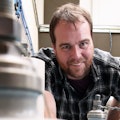The Advanced High Voltage Engineering (A-HIVE) Research Centre is based in the School of Engineering. Our modern high-voltage and high-current test laboratories are used for research into high voltage systems and phenomena in electrical power and transport applications.
With millions of homes and businesses relying on the National Grid, engineering research in high voltage electrical energy systems is very important in protecting from surges, preventing blackouts and ensuring safety, security and efficiency of the grid across the UK.
Our research into high-current lightning direct-effects finds application in the aerospace, power and communication sectors where our work is concerned principally with the lightning performance of materials, structures and systems.
Research
National Grid Centre
One of our major projects is the National Grid Centre. The National Grid Centre is a Research Centre of Excellence established in 2005 between Cardiff University and National Grid.
The Centre provides research and consultancy services as well as establishing collaborative partnerships between university researchers and company engineers. The Centre has particular expertise in high voltage insulation systems, protection against overvoltage, earthing systems and the safety of electrical systems.
Gas Insulation Systems
Gas insulation is used in a variety of applications on the high voltage transmission and distribution network including gas insulated switchgear (GIS) and gas insulated transmission lines (GIL). Air and pressurised Sulphur Hexafluoride (SF6) are used to insulate HV equipment up to 420 kV in the UK.
However, due to the global warming potential of SF6, research is currently being conducted in order to reduce or replace its use within the network with an environmentally friendly gas or gas mixture with similar electrical properties. Research has enabled a wide range of practical equipment and modelling techniques to be utilised at the university in order to investigate the electrical, physical and chemical analysis of any gas or gas mixture used in power network applications.
Specific research areas include:
- practical gaseous insulation strength testing including AC, DC and impulse breakdown voltage characteristics in pressure vessels and full-size gas insulated equipment (up to 400 kV)
- characterisation of environmentally friendly alternative insulation gases to reduce or replace the use of the global warming gas SF6
- retrofit of existing gas insulated equipment with alternative gases and gas mixtures including gas handling and gas monitoring equipment
- monitoring of gas insulated transmission and distribution equipment leakage rates and mitigation techniques
- solid deposited by-product analysis following gas degradation and electrode surface imaging analysis following an arcing event
- analysis of long/short term gaseous decomposition by-products and material compatibility
- development of solid insulation/dielectric barriers in gas insulated AC and DC equipment specifically focusing on triple junctions in GIS and GIL
- partial discharge monitoring techniques in GIS and GIL including UHF and HF sensor development and automatic software driven PD analysis
- very fast transients (VFT’s) sensor development, monitoring and modelling techniques for GIS and GIL applications
- electric field simulation and modelling techniques to simulate the behaviour of gases/gas mixtures in gas insulated equipment.
Outdoor Insulation Systems
The main functions of insulators are to withstand the mechanical stress of supporting electrical conductors and to electrically isolate equipment operating at different electrical potentials. Pollution flashover constitutes the predominant parameter for designing high voltage outdoor insulation for AC and DC electrical grids.
Two main types of insulators are employed for high voltage overhead lines and substations depending on the material used: ceramic or polymeric. Due to their enhanced performance in highly polluted environments, polymeric materials have gained extensive acceptance, but they are vulnerable to long-term degradation due to aging and weathering.
A patented design of anti-dry band insulators has been developed into full textured insulators thanks to EPSRC funded research and is currently under trials (Allied insulators and National Grid).
Specific research areas include:
- developing new laboratory procedures to assess polluted insulator performance
- visual and infrared analysis to characterise dry-bands and partial arcs on polluted insulators and its impact on insulator life expectancy
- anti-dryband texturing of silicon-rubber insulators
- non linear grading using ZnO microvaristors to control field in insulators and bushings.
Earthing Systems and Electrical Safety
The earthing system of any large electrical plant performs numerous functions:
- ensuring personal safety against electrical shocks
- providing solid earth connection for transformers and a ground path for surge arresters
- providing a path for line discharging by means of earthing switches
- providing earth connections for metallic structures and equipment.
The design of an earthing system will typically be required to conform to a standard, and installation will involve direct burial of bonded horizontal copper bar and driven vertical rods which may represent a major proportion of the cost and time associated with electrical plant commissioning.
Our research work in this area is concerned with the comparative design and evaluation of earthing systems and the development of measurement techniques for determining system characteristics in the field.
Specific research areas include:
- safety and risk assessment in earthing systems using probabilistic and computational methods
- measurements and modelling of earthing systems using dc, ac, variable frequency and impulse injections
- earthing in HVDC systems
- high frequency earth electrodes for lightning strike protection
- lightning protection and electrical safety in islanded networks
- development of controlled earth electrode test facilities.
Compact Transmission Systems and Condition Monitoring
The increase in demand and difficulties with obtaining land for new developments introduces the challenge of building new overhead lines and new substations on existing sites. Overhead line uprating offers an increased power transfer capacity without any new land requirement; with SF6 insulated substations not necessarily a preferred option anymore, the aim now is to reduce the size of transmission substations using air-insulated busbars. Adoption of new overvoltage protection schemes are one of the important actions to achieve compaction.
Additionally, the move towards smarter grids and an increased reliance on widespread condition monitoring means that communication is becoming more important. Power line communication, especially the emerging narrowband standards of Prime and G3-PLC, and new wireless protocols such as LoRa, are being investigated by our research group to provide critical new communication links. Our research work in this area is focused on increasing the visibility of electrical grids by allowing more frequent gathering of loading data, condition monitoring of assets and synchrophasor monitoring.
Specific research areas include:
- surges on networks, overvoltage protection insulation coordination
- overhead line/substation uprating and compaction
- outdoor insulators
- electric and magnetic field computations
- condition monitoring and power line communication
- induced currents and voltages
- alternative substation busbar geometries.
Lightning Direct Effects
Statistical analysis of flight reports shows that the average passenger aircraft will be struck by lightning once per year. It is for this reason that the aerospace industry adopts robust test standards for aircraft and their components that account for worst-case strike conditions.
Research of the lightning laboratory at Cardiff is focused on high current interaction with materials and structures and the development of measurement techniques for strike characterisation.
Specific research areas include:
- direct effects of lightning strikes on aerospace materials and components
- effect of lightning currents on power system components including wind turbines
- understanding conduction mechanisms, degradation effects and failure modes of carbon composite materials under lightning strike currents
- discharge phenomena and electric and magnetic field distributions in carbon composite materials and components under lightning strikes
- characterisation of degradation phenomena in carbon composite materials under combined mechanical and lightning current stresses
- contribution to the development of optimised designs for carbon composite materials and components, and hence a more‐composite aircraft
- investigating performance of coating and paints in combination with carbon composite materials
- lightning as a driver of tree mortality in the tropics.
Aerospace Insulation Systems
Decarbonisation of the transport sector is a major priority, both nationally and globally. It is estimated that the domestic and international aviation sectors constitute 2% of the global CO2 emissions arising from human activity.
The member states of the UN International Civil Aviation Organisation are committed to offset any increases in emissions beyond 2020 which, combined with the drive for increasing fuel efficiency, will stimulate aircraft weight reduction beyond that already achieved through the adoption of composite airframe materials.
The more-electric aircraft (MEA) concept permits higher system efficiencies to be realised through electrification of traditional mechanical and hydraulic aircraft subsystems. The MEA can also be considered a stepping stone to realising a commercial all-electric aircraft (AEA).
MEAs and AEAs will be equipped with more diverse and safety-critical subsystems, based on high density power electronic converters and direct-current power distribution in excess of 1000 Volts. The increased stress experienced by cable insulation, connectors and other equipment, combined with extreme and dynamic environmental conditions experienced in flight, presents a number of technical challenges.
Specific research areas include:
- insulation coordination at altitude
- high-voltage switched dc and its influence on insulation stress
- dynamic altitude and atmospheric effects on insulation performance
- condensation and icing
- effect of increasing system voltages on the frequency and severity of temporary over-voltage events
- lightning indirect effects.
Meet the team
Centre Director
Academic staff
Associated staff
Postgraduate students
Facilities
High Voltage Laboratory
The high voltage laboratory at Cardiff is a modern research facility with extensive expertise in gaseous and solid insulation systems, overvoltage protection, condition monitoring, earthing and electrical safety. It has been home to the National Grid Centre since 2005, and is internationally recognised for its high voltage engineering research.
Research in the high voltage laboratory is focused on the development of flexible and sustainable power transmission technology, while ensuring safety of personnel and the general public.
Our main research areas include:
- alternative insulation gases with low global-warming potential
- long-term performance of polymeric insulation
- fault location on power networks
- high-frequency earthing.
We have extensive experience in developing test apparatus and measurement techniques in-house.
Lightning Laboratory
The Morgan-Botti Lightning Laboratory is a unique University-led lightning direct effects research facility established in 2011 as a collaboration between Cardiff University and Airbus Group Innovations (formerly EADS). The Lightning Laboratory is capable of generating controlled lightning up to 200,000 amps, more than five times the magnitude of the average lightning strike.
Research at the Lightning Laboratory is helping further understanding of lightning effects on materials and reducing the environmental impact of air travel, as well as making it safer and more efficient.
The laboratory's main research interests include measurement of lightning direct-effects on structures and samples and investigating lightning protection mechanisms for the aerospace industry. We have experience in developing new sensing and measurement techniques appropriate to the harsh environment of the direct effects test laboratory.
Schools
Next steps
Research that matters
Our research makes a difference to people’s lives as we work across disciplines to tackle major challenges facing society, the economy and our environment.
Postgraduate research
Our research degrees give the opportunity to investigate a specific topic in depth among field-leading researchers.
Our research impact
Our research case studies highlight some of the areas where we deliver positive research impact.










